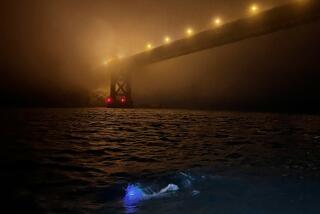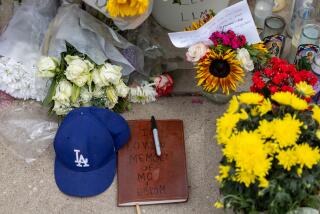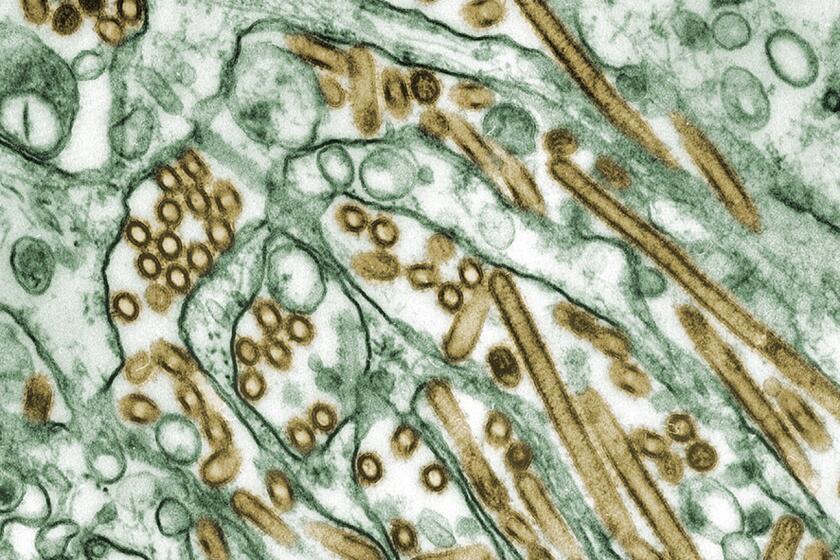Sea World Busy Aiding Sea Mammals : Ocean life: Large numbers of seals and sea lions are beaching along the coast, putting animal rescuers like the aquatic park to work.
Sea World officials are expecting this year to be one of the busiest for treating injured sea animals along the Southern California coast, already having treated 178 mammals.
Sea World rescues an average of 120 mammals a year, most of which are harbor seals, California sea lions and northern elephant seals. In general, they are found along the California coast, according to Tom Goff, Sea World’s curator of mammals and head of the park’s Beached Animal Recovery Program.
Goff said their busiest year was 1983 when they treated 475 animals. At the time the Pacific Coast was experiencing the effects of El Nino, a periodic warming trend in the Pacific Ocean that disrupts marine life.
Goff, who has worked with the beached animal program for 11 years, said there are a number of reasons for the high numbers of rescues, including recent storms that broke the ocean’s food-chain cycle and thus made it difficult for the young animals to find nourishment.
“They are fighting the storm, and they get more tired and more dehydrated,” said Corrine Brindley, spokeswoman for Sea World.
Besides the weather, Goff said, the mammals are giving birth at an exceedingly high rate.
Marine mammal “census workers have told us there are large numbers of pups on the Channel Islands,” he said. “This is a big year.”
The increase of stranded mammals has been found throughout the California coast this year, according to Joe Cordaro, wildlife biologist with the National Marine Fisheries Service office in Los Angeles. Although the population increase is not overwhelming, the numbers are growing steadily, he said.
These animals “don’t have natural predators” in this area, Cordaro said. Their only predators, the killer whale and the great white shark, are not indigenous to the area.
Cordaro said rehabilitation centers located along the California coast have received higher than average numbers of seals. During a two-week rainy period, he said, 180 animals were reported picked up by seven mammal rehabilitation centers.
Seals, in particular, many of which were born in March and April, are having a problem getting food. Once they stop feeding from their mothers, they must find their own food or die.
Unlike other animals, seals are not trained by their parents to get food. The animals rely on their instincts to find nourishment.
If the pup cannot find food, it can become weak, malnourished, dehydrated, hypothermic and vulnerable to respiratory infections and parasites. In that condition, they often become victims of stronger animals such as sharks, Goff said.
By the time an animal hits the shore, it usually feels so sick that beaching itself is a last ditch survival effort, Brindley said.
Brindley cautioned that, although the animals appear cuddly and harmless, they are still wild.
“The animals are scared and they do have teeth and they do bite,” Brindley said.
Goff recommended that when someone finds an animal, to leave it alone and call Sea World, local animal control officers, police or lifeguards.
These agencies will monitor the animal to see if it is sick, injured or resting. If the animal appears to be sick or injured, the proper animal care agency will respond to help.
Once the animals get to Sea World, they are given complete physical exams to check for injuries, trauma and any other health problems, Goff said.
Animals that go through the program are tagged and the information turned over to the California Marine Mammal Stranding Network, which is part of the larger National Marine Fisheries Service.
Goff said animals normally stay in the rehabilitation program for 30 to 90 days.
During that time, animals may receive antibiotics, intravenous fluids and other medication, if needed, at Sea World’s Animal Care Facility.
Goff estimated that 50% to 60% of the animals that go through the rehabilitation program recover and return to the wild. The rest die.
For the survivors, part of the rehabilitation program may include learning to catch food.
“We have to feed them until it clicks,” Goff said. “They have to compete for their food with the others. Once they can compete, that makes them good candidates for release.”
More to Read
Start your day right
Sign up for Essential California for news, features and recommendations from the L.A. Times and beyond in your inbox six days a week.
You may occasionally receive promotional content from the Los Angeles Times.






